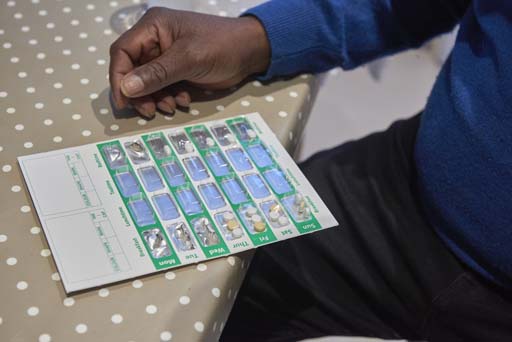4.5 What are the main drug treatments for Parkinson’s?
The person you are caring for may be taking one or more of the following types of drugs. Some of these are available in generic form as well as the branded options mentioned. Most people in the advanced stage (often called the ‘complex phase’) of Parkinson’s will be on some form of levodopa and/or dopamine agonists. Speak to their GP, specialist or Parkinson’s nurse if you need more information about the drugs a person with Parkinson’s is taking.
Levodopa
Levodopa has been used to treat Parkinson’s since the 1960s and is still the most effective drug treatment for Parkinson’s. This drug is a chemical building block that the body converts to dopamine, the chemical that is lacking in the brains of people with Parkinson’s. Types include co-beneldopa (Madopar or generic form) and co-careldopa (Sinemet, Duodopa, Caramet, Lecado, Stalevo or unbranded form).
There are different forms of each drug. There is a dispersible form of Madopar that may be swallowed whole or dissolved in water. Madopar capsules should not be broken. There is no dispersible Sinemet. Duodopa is an intestinal gel, which is pumped continuously through a tube that is surgically inserted in the intestine.
For details of controlled-release options, read our booklet Drug treatments for Parkinson’s [Tip: hold Ctrl and click a link to open it in a new tab. (Hide tip)] .
Levodopa and protein
For some people with Parkinson’s, protein (which is found mainly in meat, fish, eggs, cheese, beans and pulses) seems to interfere with how well levodopa is absorbed by the body. Because of this, people you care for may benefit from taking medication 30-60 minutes before they eat a meal.
However, levodopa can sometimes make people feel sick. Eating a low protein snack (such as crackers) when they take their dose may help to reduce this side effect.
It is important that people do not stop eating protein altogether, as it is vital to help the body renew itself and fight infection.
Tests restricting the intake of daytime protein have been tried by people with severe Parkinson’s symptoms and, in some cases, they have shown an improvement in their response to levodopa. This is called a protein redistribution diet where protein is saved until the evening and is suggested as a recommendation in NICE guideline [NG71] Parkinson's disease in adults (2017).
A person’s specialist or Parkinson’s nurse can advise on timing doses, and a dietitian can also provide advice.
Find out more in the Parkinson’s UK diet and Parkinson’s information.
Dopamine agonists (oral)
These drugs help to improve movement symptoms and are used at all stages of Parkinson’s. The most common examples include ropinirole (Requip, Requip XL or unbranded form), rotigotine (Neupro), and pramipexole (Mirapexin or Mirapexin PR).
The following dopamine agonists are not so widely used but you may still find the occasional person taking them: cabergoline (Cabaser or unbranded form), bromocriptine (Parlodel or unbranded form), and pergolide.
Dopamine agonists (injection or infusion pump)
Apomorphine (APO-go and Dacepton) is given by injection or infusion pump. Usually this will be given by nurses trained by an expert. This medication can cause short-term nausea and sickness, so an anti-sickness drug called domperidone (Motilium) will also be given at least two days before your apomorphine treatment.
Glutamate antagonist
Amantadine is the only glutamate antagonist that can be prescribed. There isn’t much evidence that amantadine can improve tremor and other motor symptoms of Parkinson’s. But it can be used to treat involuntary movements (dyskinesia) if other Parkinson’s medication has not been effective. Amantadine is available as capsules or in syrup form.
COMT inhibitors
These include tolcapone (Tasmar), entacapone (Comtess) and Stalevo. COMT inhibitors are used with levodopa, slowing its natural breakdown to make sure that it reaches where it is needed in the brain.
Stalevo is a combination drug therapy in one tablet. In addition to carbidopa and levodopa (active ingredients in Sinemet), Stalevo contains entacapone, a substance that enhances the benefits of levodopa.
MAO-B inhibitors
A MAO-B inhibitor can be used on its own in early Parkinson’s, or in combination with other drugs at all stages of Parkinson’s. Selegiline (Eldepryl, Zelapar or generic form) and rasagiline (Azilect) are often taken in the morning as they are stimulants, so they could keep people awake if they take them at night.
Anticholinergics
These include trihexyphenidyl (benzhexol), procyclidine (Kemadrin or generic form) and orphenadrine (Biorphen or generic form). Benzhexol, orphenadrine and procyclidine are available in liquid form.
Domperidone (Motilium) is the anti-sickness drug of choice to prevent and treat nausea and vomiting caused by levodopa.
Domperidone can cause heart rhythm problems (arrhythmias) in some people over the age of 60. If your client is taking this medication, you should inform your manager, who can talk to their specialist, Parkinson’s nurse or pharmacist. You should also understand what the signs of irregular heart rhythms are. These can include feeling faint, breathless or dizzy.
Other anti-sickness drugs that are generally considered useful include cyclizine (Valoid) and 5-HT3 receptor antagonists like ondansetron.
Drugs to avoid
Some drugs can bring on Parkinson’s-like symptoms or interact with Parkinson’s drugs. They should be avoided unless they’re recommended by a specialist. For hallucinations/confusion, avoid:
- chlorpromazine (Largactil)
- fluphenazine (Modecate)
- trifluoperazine (Stelazine)
- flupenthixol (Fluanxol/Depixol)
- haloperidol (Serenace/Haldol)
For nausea and vomiting, avoid:
- metoclopramide (Maxolon)
- prochlorperazine (Stemetil)
Domperidone (Motilium) is the anti-emetic of choice to prevent and treat nausea and vomiting caused by Parkinson’s medication. This is available orally or as suppositories. If an injectable or alternative antiemetic is required, cyclizine (Valoid) may be considered.
For coughs and colds, avoid:
- preparations containing sympathomimetics (such as pseudoephedrine and ephedrine) with MAO-B inhibitors
This is because there is a risk of hypertensive crisis - high blood pressure, which in extreme cases can cause a stroke.
Vigilance is particularly required with the use of:
- antihistamines, especially cinnarizine (Stugeron/Arlevert) which, if used long-term, can mimic Parkinson’s symptoms
- antipsychotics
If these drugs are taken, they can cause people with Parkinson’s to become very unwell and it can take them a long time to recover, even when the offending drug is stopped. It is important that you are aware of drugs that could harm the person you are caring for, even if you are not responsible for administering drugs.
Find out more in the Parkinson’s UK drug treatments information.
Pain relief
Many people with Parkinson’s also take some type of pain relief medication for their symptoms. It is vital that pain relief is available as their Parkinson’s progresses, especially in the end-of-life phase. A person’s specialist or Parkinson’s nurse can help with this.
4.4 What is medication management?

